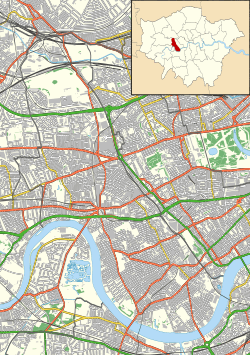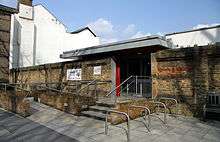HM Prison Wormwood Scrubs
|
Entrance to Wormwood Scrubs Prison | |
 Wormwood Scrubs | |
| Location | Wormwood Scrubs, London |
|---|---|
| Coordinates | 51°31′00″N 0°14′25″W / 51.516667°N 0.240278°WCoordinates: 51°31′00″N 0°14′25″W / 51.516667°N 0.240278°W |
| Status | Operational |
| Security class | Adult Male/Category B |
| Capacity | 1,279 |
| Population | 1,227 (as of 11 August 2017) |
| Opened | 1875 |
| Managed by | HM Prison Services |
| Governor | Steve Bradford |
| Street address | P.O. Box 757, Du Cane Road |
| City | London |
| Postal code | W12 0AE |
| Country | United Kingdom |
| Website | Wormwood Scrubs at justice.gov.uk |
HM Prison Wormwood Scrubs (informally "The Scrubs") is a Category B men's prison located in the Wormwood Scrubs area of the London Borough of Hammersmith and Fulham, in inner West London, England. The prison is operated by Her Majesty's Prison Service.
History
19th century
The initial steps in the winter of 1874 involved the construction of a small prison made of corrugated iron and a temporary shed to serve as a barracks for the warders. Nine specially picked prisoners, all within a year of release, completed the buildings, after which 50 more prisoners were brought to erect a second temporary prison wing. Building then began on the permanent prison, with bricks being manufactured on site. By the summer of 1875, enough bricks had been prepared to build the prison's first block and its ground floor was finished as winter began. Construction was completed in 1891.[1]
The Second World War
During the Second World War, the prison was taken over by the War Department and the prisoners were evacuated to other prisons. It was used as secure office space for the duration of hostilities, and housed MI5 and MI8.
Modern era
In 1979, IRA prisoners staged a rooftop protest over visiting rights. Sixty inmates and several prison officers were injured. In 1982, an inquiry blamed much of the difficulties on failings in prison management. The Governor, John McCarthy, had quit before the rioting. In a letter to The Times, he had described Wormwood Scrubs as a "penal dustbin".
In the 1990s, a police investigation into allegations of staff brutality resulted in the suspension of 27 prison officers and the conviction of six for assault, though three later won appeals against conviction. The Prison Service paid out more than three million pounds in out-of-court settlements with ex-prisoners who had alleged brutality. Her Majesty's Chief Inspector of Prisons delivered a damning report on the conditions, in which the prison was told to improve or close.
In March 2004, a further report from the Chief inspector stated that Wormwood Scrubs had greatly improved after making fundamental changes. Three quarters of inmates at the prison had said that staff treated them with respect, which was better than the national average. However, the report also stated that inmates spent too much time in their cells, and that only 36 per cent of eligible inmates were involved in education or work.[2]
In November 2008, another report from Her Majesty's Chief Inspector stated that conditions at Wormwood Scrubs had deteriorated since the last inspection. Heightened prison gang activity had been detected, and 20 percent of prisoners had failed drugs tests.[3]
On 10 March 2009, the prison was listed as a Grade II building, principally because of its distinctive gatehouse.[4]
Major structural changes to the prison's management took place in 2013. In 2014, another report by Her Majesty's Inspectorate of Prisons was critical of the prison, describing it as "filthy". The inspectors also stated that there had been a failure to put into place recommendations by the Prisons and Probation Ombudsman to deal with suicide and self-harm. The Chief Executive of the Howard League for Penal Reform, a charitable body, said "I have never seen a public service deteriorate so rapidly and so profoundly."[5]
The prison today
Wormwood Scrubs is a Category B prison for adult males, sentenced or on remand from the local courts. The prison has five main wings and a number of smaller dedicated units. All the accommodation has electricity and integral sanitation with a TV and accompanying bedroom furniture:
- A wing – remand and sentenced prisoners
- B wing – induction wing
- C wing – prisoners on an Intensive Drug Treatment Service
- D wing – high risk prisoner requiring single cells
- E wing – for prisoners attending Education
- Super enhanced wing – enhanced prisoners who are considered to be trustworthy
- Conibeere Unit – prisoners who require a substance misuse stabilisation regime
- First Night Centre – for prisoners during their first day(s) in custody
There is a contracted prison shop previously run by Aramark, but now run by DHL, which provides a selection of consumables for purchase by prisoners.
The two oval plaster reliefs on the front of the prison depict Elizabeth Fry and John Howard, both well known figures in prison reform.

In 2017, the prison was reportedly overcrowded and infested with rats and cockroaches. Some prisoners are locked in their cells for 23 hours a day. The prison is reportedly dangerous for staff and inmates, prisoners outnumber prison officers, and officers are concerned for their safety. There are 40 to 50 violent incidents a month.[6][7] Peter Clarke described “an extremely concerning picture” including, "intractable failings" continuing since earlier inspections from 2014.[8]
In 2018, a prisoner was stabbed to death and three other prisoners were charged with his murder.[9]
Notable inmates
- Paul Blackburn
- George Blake
- Reginald Horace Blyth
- Horatio Bottomley
- Ian Brady
- Charles Bronson
- Basil Bunting
- Leslie Grantham
- Morris Cohen
- Fred Copeman
- Pete Doherty
- Lord Alfred Douglas
- John Hampson
- Nicholas van Hoogstraten
- John Hopkins
- Keith Richards
- Thomas William Jones, Baron Maelor
- Mike Lesser
- Saunders Lewis
- Konon Molody
- Mark Morrison
- Timmy Murphy
- Owen Philipps, 1st Baron Kylsant
- Count Geoffrey Potocki de Montalk
- Richard Starkie
- John Stonehouse
- Michael Tippett
- Lewis Valentine
- David John Williams
- Nikos Sampson
- Murdoc Niccals
In popular culture
Literature
- Death of a Train (1946) An Inspector French Mystery by Freeman Wills Crofts
- One of the main characters in Sarah Waters's novel "The Night Watch" (2006) served his sentence at the Scrubs.
- Peter Wildeblood was imprisoned in the Scrubs in 1954. His book "Against the Law", describes his trial and imprisonment.
- The prison is mentioned in the Russian novel Figurehead, by Danil Koretsky (Данил Корецкий, Подставная фигура). The parents of the principal character are held in the Scrubs and are unsuccessfully sought-out by the Russian SVR.
- Bunny Manders, the narrator of the A. J. Raffles stories by E. W. Hornung, serves his sentence at Wormwood Scrubs.
Film and television
In films and TV programmes set in Britain the front entrance of Wormwood Scrubs is frequently chosen as a location for scenes showing a character being released from prison, as, for example, in:
- Billy Liar
- The Man In Possession
- The Spy Who Came in from the Cold
- The Horse's Mouth
- Hot Millions
- A Very British Coup
- Cass
- The Sweeney – "One of Your Own"
- The Italian Job'
- The Baron – "Something for a Rainy Day"
- Porridge (both the television series and the film)
- Minder, in the episodes "Bury My Half at Waltham Green" and "The Birdman of Wormwood Scrubs"; Terry McCann, the titular minder, also served his time in the Scrubs before the series began and the front of the prison can be seen in the opening credits.
- Danger Man – in the episode "Such Men Are Dangerous" John Drake (played by Patrick McGoohan) is substituted for a man being released and is shown leaving the Scrubs.
- Steptoe and Son
- Rumpole of the Bailey series 2 "Rumpole and the Age for Retirement" 1979
- The Slammer used the prison doors to show winners of the Freedom Show being released.
A two-part documentary, Wormwood Scrubs, was shown on ITV1 in May 2010.
Music
- Gary Moore is shown being escorted out of the prison entrance by a guard on the cover of his 1978 album, Back on the Streets.
- The prison is mentioned in The Jam's hit song, "Down in the Tube Station at Midnight" and in Billy Bragg's 'Rotting on Remand' from the Workers Playtime album.
- The Pete Doherty song "Broken Love Song" is about the singer's tenure in the prison in early 2008.
- Spike Milligan recorded "The Wormwood Scrubs Tango" about an elderly car thief in the prison.
- In 2018 Murdoc Niccals, fictional bassist for the virtual band Gorillaz, was sent to the prison in the story surrounding the album "The Now Now".[10][11]
References
- ↑ Sims, George R. (1978). Living London. Рипол Классик. ISBN 9785878036856. Retrieved 13 August 2018.
- ↑ "Jail conditions at Scrubs improve". BBC News. 23 March 2004. Retrieved 13 August 2018.
- ↑ "'Urgent' changes needed at prison". BBC News. 18 November 2008. Retrieved 13 August 2018.
- ↑ Bar-Hillel, Mira (10 March 2009). "'Ere Fletch they've only gone and listed the Scrubs: HMP Wormwood officially one Britain's finest buildings". Mail Online. Retrieved 13 August 2018.
- ↑ "HMP Wormwood Scrubs 'Filthy and Unsafe', According to Report". 3 September 2014 – via www.bbc.co.uk.
- ↑ Wormwood Scrubs 'Dangerous for Inmates and Officers' BBC
- ↑ Wormwood Scrubs Prison Sees 'Surge in Violence' BBC
- ↑ Travis, Alan (8 December 2017). "Inspector finds dramatic increase in violence inside London prison". The Guardian. Retrieved 13 August 2018.
- ↑ "Three men charged with inmate's murder". BBC News. 3 February 2018. Retrieved 13 August 2018.
- ↑ Smith, Thomas (17 July 2018). "Gorillaz: Murdoc hits back at 2D in exclusive prison interview - NME". NME. Retrieved 13 August 2018.
- ↑ Crewther, Joseph (31 May 2018). "We Visited Murdoc in Jail to Learn about the New Gorillaz Album". Noisey. Retrieved 13 August 2018.
External links
| Wikimedia Commons has media related to HM Prison Wormwood Scrubs. |